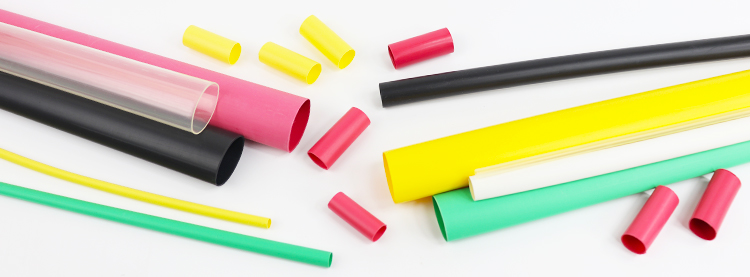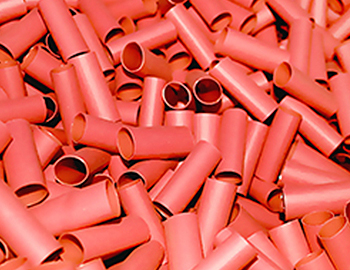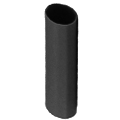Categories
Need Help?
Click HereGet a Business Account
Apply HereHeat Shrink

What is heat shrink?

The term heat shrink refers to any number of thermoplastic materials that reduce in diameter when heated. Commonly heat shrink is used to protect or insulate wires. In this way, it creates a barrier to protect the wires from abrasion, environmental conditions, and even chemical exposure. It is often available in a range of colors depending on the style you select. The important thing to remember when dealing with electrical connections is to use heat shrink that is lined with epoxy. That epoxy will melt when heated and create a water tight seal further protecting your electrical connections. Now that we have covered what heat shrink is, let us take a look at the different types of heat shrink that are available.
"The important thing to remember when dealing with electrical connections is to use heat shrink that is lined with epoxy."
How do I choose the correct heat shrink?
Heat shrink is used to provide protection from abrasion, cutting, impact, and exposure. It is primarily available in three distinct styles: 2-to-1, 3-to-1, and heavy wall. It is important to understand the differences so that you can get the proper solution for your task. As you might imagine 2-to-1 heat shrink reduces to 50% of its original diameter. Following the same logic, 3-to-1 reduces to 1/3” its original size. Heavy Wall heat shrink carries a much thicker wall to provide additional protection as well as strain relief. The most important aspect of choosing the right heat shrink is selecting one that offers epoxy lining. Alternatively, epoxy lined heat shrink terminals offer the same high level protection. It is this epoxy lining, that when heated, melts to flow and create an environmentally sealed connection.
Where is heat shrink implemented?

Heat Shrink is one of the most useful wire management products
Heat shrink is implemented in situations where wire, cables, or electrical connections need to be protected. To be honest, heat shrink has a multitude of uses and is one of the most common wire management products out there. It is commonly used on new installations but works just as well when replacing parts. Perhaps you need to replace old heat shrink or have damaged heat shrink. In that case, these are the perfect products for you. All you need are the proper tools, marine wire, and battery cable.
What types of heat shrink are available?
Heat shrink comes in a variety of styles and we carry the most popular so that you can find the solution that is perfect for your specific needs. Each of these types of heat shrink offers a benefit or feature not found in the other types. All of our heat shrink is epoxy lined other than the heavy wall type. Below we will take a more in-depth look at each of these so you can hopefully make a more informed buying decision.
2-to-12-to-1 heat shrink reduces its ratio when heated to one half of its original diameter. So, ½” diameter 2-to-1 heat shrink will reduce to ¼” diameter. It is useful in applications such as insulation, wire bundling, wire identification, and mechanical protection. Our 2-to-1 heat shrink is flexible and offers high tensile strength. This makes it the ideal choice for use in marine environments.
3-to-13-to-1 heat shrink is the exact same as 2-to-1 however, instead of reducing its diameter by 50%, the diameter is reduced by 66%. This is more advantageous in situations where a tight fit is required but installation space is limited. The larger diameter will allow it to more easily fit over wires and cables potentially cutting down on installation time.
Heavy wallHeavy wall heat shrink reduces by a ratio of 3-to-1 however, this type of heat shrink is much more durable and less flexible. This makes it the perfect choice for applications where abrasion, impact, and chemical exposure are more of an issue. Heavy wall heat shrink is the only type we offer that is recommended for direct submersion due to the high level of protection it offers.
What is the difference between 2-to-1 and 3-to-1 heat shrink?

The difference between 2-to-1 and 3-to-1 boils down to the shrink ratio. That is to say that 2-to-1 reduces to half its original diameter whereas 3-to-1 reduces to one third its original size. So, a ½” (0.50”) piece of 2-to-1 will reduce to a ¼” (0.25”). In contrast, a ½” (0.50”) piece of 3-to-1 will reduce to (0.167”). Hopefully, these examples make it easier to determine which type of is right for your application. Just remember, 2-to-1 reduces to half the original diameter and 3-to-1 reduces to one third. It’s that simple.
Where would I use these products?

You can use heat shrink in just about any application where you need to protect exposed portions of conductors or electrical connections. Most commonly, people use it in their cars, boats, homes, and businesses. They are used in a multitude of industries as well such as automotive, aviation, transportation, data transmission, power management, communications, and more. Many boaters actually keep a stock of heat shrink on their boats just in case they need to make emergency repairs on the spot while out on the water.
What lengths are available?

Pacer offers heat shrink in three different lengths 1.5”, 12”, and 48”. This is so that you can get the sizes that you need. Not everyone needs a four-foot stick of heat shrink, but some people do need it. Sometimes, all you need are a few 1.5” pieces to complete your project. This is why we made a point to offer the most useful lengths possible. So that you can find the length that you need to get your project completed.
What makes heat shrink advantageous?
Heat shrink is advantageous for a variety of reasons such as it is easy to use, it is available in multiple colors as well as sizes, it can be cut into specific lengths, it is moisture proof, it creates a complete seal when it has an epoxy lining, and it is built for longevity. This is on top of it providing abrasion and impact resistance. The bottom line is that heat shrink works like a barrier or armor for the surfaces that it covers. Using heat is not only smart it is a necessity in many applications especially when electricity and moisture are involved. One question that we often receive is how do I use heat shrink?
![]()




How do I use heat shrink?
Heat shrink is, as we said above, a thermoplastic material that reduces in diameter when heated. To use it, all you need to do is apply the proper amount of heat at the proper distance until it has fully reduced in diameter. To do this properly you will need to employ the proper tools as just using a lighter will potentially burn the heat shrink body or the surface you are covering. It is important to note that if you overheat the heat shrink it will discolor or bubble. If this occurs, you need to remove and replace it as its protective qualities will have been compromised. So now let us take a look at which tools are best suited for use with heat shrink.

What tools do I use with heat shrink?

If you want the ideal results, you need the correct tools, and this holds true for heat shrink. We offer a range of heat tools to handle just about any job you can think but the one best suited for heat shrink is our Proheat heat gun. This heat gun heats up to reach 1000°F / 540°C and is lightweight meaning it is perfect for field service or even home usage. Its balanced design prevents operator fatigue, and it has two separate heat settings. The bottom line is that if you are working with heat shrink, this is the tool you’ve been looking for.
What does epoxy lined really mean?
Epoxy refers to glue so when we say epoxy lined, we mean the inside of the heat shrink tube has a lining of glue. Glue that when melted pushes out to form an environmental seal. Epoxy lined heat shrink is essential in applications that require exposure to moisture or other environmental hazards. Without the epoxy lining, you are leaving your connections vulnerable to exposure which can compromise your electrical system. We highly recommend using epoxy lined heat shrink in most applications as even if there is no moisture, it still creates a more durable protective seal.
What industries use heat shrink?
Heat shrink is employed in a wide range of industries due to its ease of installation and protective qualities. This is why you will find heat shrink in use in the marine, automotive, aviation, communication, database, RV, battery management, and solar industries. To be honest, it is used in way more industries than that, but you get the point. Selecting the correct heat shrink for your application isn’t always an easy choice, contact a Pacer expert today with any questions that you may have.
![]()
![]()
![]()
![]()
*This page was updated on 2/08/2023*





